
Speaker Bercow has selected just three amendments to be voted on by MPs who will consider the government’s latest amendable Brexit motion this evening.
The most closely fought is likely to be Tory Remainer Anna Soubry’s, which calls on the government to release the most recent briefing to cabinet on the implications of a no-deal Brexit. Labour has yet to confirm it will support this amendment. This motion is not binding so the government will not have to release the briefing – although they will come under pressure to if it passes.
If Soubry’s amendment passes, there will be no vote on the government’s motion. The government’s motion is to reiterate parliament’s support for what parliament voted for on 29th January. This was when parliament voted to send Theresa May back to Brussels to renegotiate and, in a separate vote, to rule out no deal. The hard-Brexit wing of the Tories object to reiterating support for ruling out no deal and so may vote against the government.
The Labour leadership have their own amendment selected. It aims to stop Theresa May running the clock down on Brexit by requiring the government to hold another meaningful vote or allow parliament to take control of the process should the Prime Minister have failed to secure support for a deal before February 26th.
The final selected amendment is the SNP’s, backed by the Lib Dems which calls for the government to immediately begin negotiations with the EU to extend Article 50 by at least three months. The SNP says this is “to avoid the Brexit cliff edge”.
Ken Clarke’s amendment requiring indicative votes has not been selected. Neither has Sarah Wollaston’s, which would have made parliament hold binding votes on four options (May’s deal, no deal, Norway and referendum). If more than one of these options had been approved, then the public would choose between them.




More from LabourList
‘The missing ‘B’ – the case for a national smartphone ban in schools
Labour members blame austerity and Brexit for economic problems – poll
‘Britain’s high streets need Community Investment Zones’